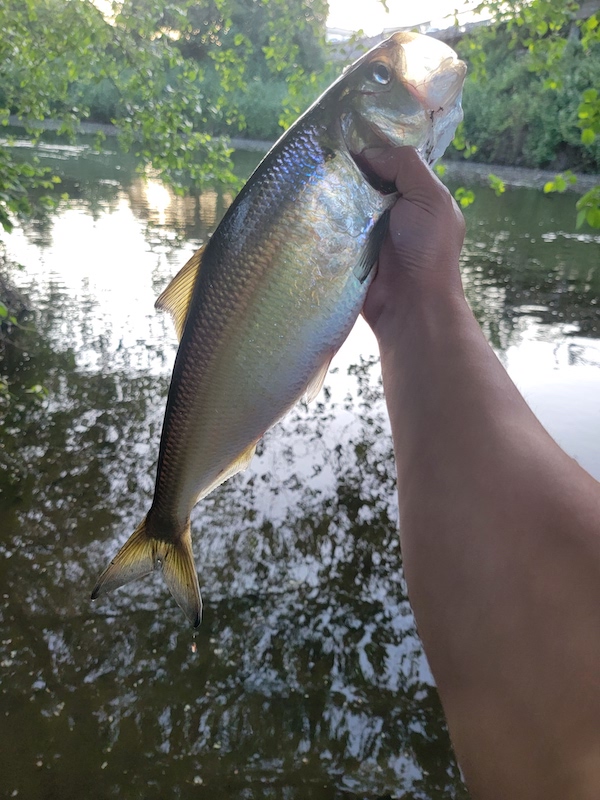
American Shad Caught In Sammamish Slough
Updated 9:50 a.m., June 6, 2023
Some of Lake Washington’s new population of American shad appears to be making a spawning run up the Sammamish Slough this spring.
Angler Kaden Dechant reported hooking at least four last week, landing two and losing the other pair, with one breaking his 6-pound-test in getting away.

He was actually fishing for panfish with little jigs on the slough that runs from Lake Sammamish to Lake Washington when they bit, giving him quite a tussle on light gear, according to information he shared with state fisheries biologist Aaron Bosworth.
“He said they put up an incredible fight,” said Bosworth.
Unaware that there’s a suddenly growing population of shad in Lake Washington – we reported on it earlier this spring – Dechant decided to contact WDFW in case the species is invasive.
They are, and his catches help determine where the East Coast species originally transplanted to the Columbia and Sacramento in the late 1800s are apparently going to spawn in the Lake Washington watershed.
Bosworth indicated that Dechant is the first he’s aware of to have successfully caught shad on a rod and reel in the slough. More angler catches could provide additional information on the run.

Not much is known about Lake Washington shad. Before 2021, all of 29 had ever been netted in the big lake, but starting in 2021 the numbers suddenly began to climb – a total of 108 caught by the Muckleshoot Tribe while targeting other species, 215 in 2022 in similar operations, and as of earlier this year, WDFW had netted at least 1,000–plus and the Muckleshoots are believed to have caught close to twice as many.
In follow-up comments Tuesday morning, Bosworth stated that this year’s net catches – some of which focused on deeper areas of the lake than before – indicates that the population appears to be getting larger.
Preliminary genetic work on a limited sample suggests that, unlike those in the Columbia, which go to sea for several years, at least some of Lake Washington’s shad rear and spawn entirely in the system, making them very unusual in the world of Alosa sapidissima.
In Washington, there is no size restriction or daily or possession limits on shad, which are only open during game fish seasons. On the Sammamish, which is defined as the 68th Avenue Bridge in Kenmore upstream to Lake Sammamish, game fish season runs January 1-August 31. Fishing there is only open under selective-gear rules.
Where shad anglers below Bonneville Dam on the Columbia and Oregon City on the Willamette use 1-ounce sinkers to get their plain jigs, shad darts or Dick Nites down to the bottom where shad are running upstream, no such weight will really be needed on the languid, weedy and shallow Sammamish.
Columbia and Willamette anglers tend to keep them for crab or sturgeon bait, but the bony fish can be fried and prepared other ways for the table.
They ain’t making too many new runs of fish these days, but for better or worse, one appears to be beginning in the slough.

IN UTTERLY UNRELATED NEWS, WDFW reports that crews on Lake Washington are attempting to remove non-native pond slider turtles using traps and nets, as well release some for a mark-recapture study to figure out their movements and populations, research led by Puget Sound Energy and other partners.
And as for dead yellow perch washing up on some parts of Lake Washington, those fish appear to have succumbed to the rigors of the spawn, warming lake waters and columnaris, a “naturally occurring bacterial infection that affects many fish in Lake Washington” and to which postspawn perch are susceptible to. Like American shad and pond slider turtles, yellow perch are not native but exist in the lake in vast numbers.
